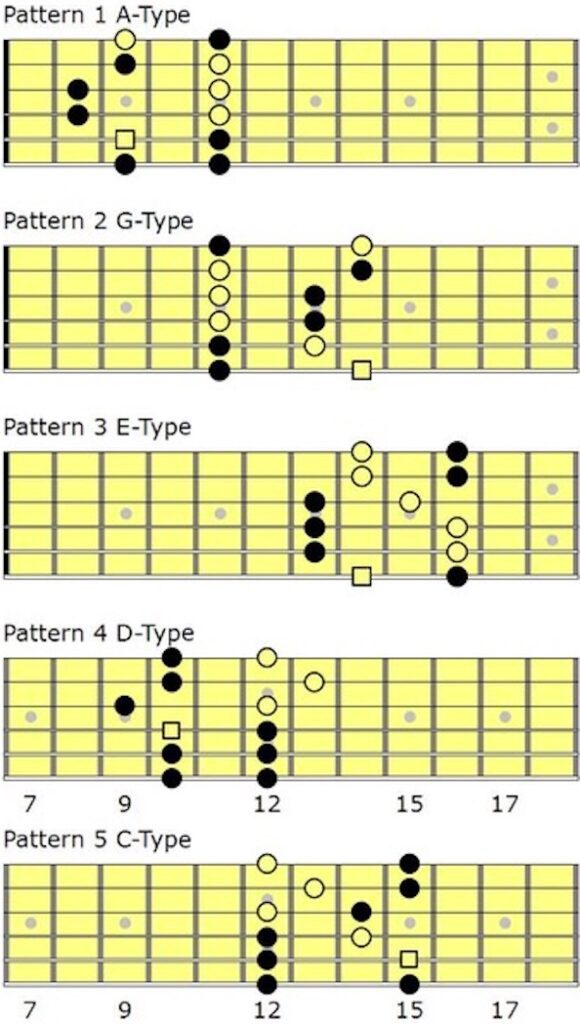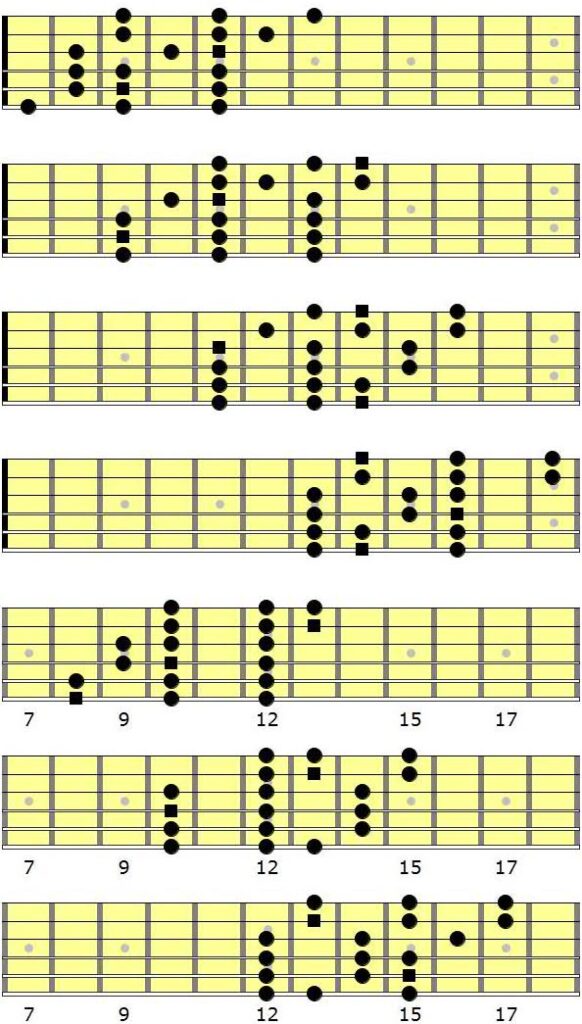How To Remember Scales on Guitar – 5 Tips for Practicing
Since the guitar gives you an enormous choice of playing the same notes and scales with different fingerings, getting to grips with all possible scales and patterns within a key can be a daunting task. A lot of things don’t seem very logical, especially at the beginning, and the abundance of scale fingerings that you’re supposed to master in all keys can seem quite overwhelming. In this guide, we offer five tips for remembering scales on guitar.
Luckily, there are a few ideas and tricks on how to master the many scales on the guitar and how to play over changing tonal centers. Generally speaking, most exercises are based on two basic principles: “one position – all keys” or “all positions – one key”. In this article, I’ll show you a few methods for remembering guitar scales.
Remembering Scales on Guitar: Fretboard division in the CAGED system and three-note-per-string pattern
At the beginning, it is recommended to divide the scale patterns into positions. On the one hand, these can be done according to the CAGED system, which means that each pattern is assigned a chord fingering (C, A, G, E, and D scheme). Based on the chord shapes and root note, you can quickly find the correct fingering in each key. Here’s an example in C major:
The division into three-notes-per-string patterns (3 NPS) is very practical, especially for playing scale sequences and runs, even if they require a few position changes and the shapes appear slightly diagonal. This is what the C major scale looks like in 3 NPS:
Scale Sequences on Guitar
Once you know your scale fingerings by heart, it is a good idea to play through a few sequences in order to master the scale. Simply speaking, a sequence is a series of notes that is repeated in all keys. These sequences can be either note groups (groups of three, groups of four), intervals (thirds, fourths, etc..), or harmonic structures (triads, fourths, their inversions, etc).
Here is an example of a G major scale in groups of four:
Horizontal Scale Exercises on Guitar
On guitar, playing “horizontally” means going through all the patterns within the keys on one or more strings, quite the opposite of vertical scale playing. Through these exercises, you learn to break up the static pattern thinking, which helps to elegantly link the various scale patterns together.
Here is an example of a horizontal sequence on the E and B strings in the key of A minor:
Through the Keys in a fixed Position
In this exercise, we choose a fixed position, which we may only leave by one fret up or down. Now we write down all 12 root notes in any order, such as:
Eb G E G# C A F C# Bb Gb B D
The notes mark our root notes (or keys). Now we play these scales in the chosen position, plus/minus one fret, e.g. the Eb major scale, G major scale, E major scale, etc. in the third position.
Through this exercise, you’ll become extremely fit in all keys, which means that playing over changes will be extremely easy for you.
An example for third position would look like this:
Mastering Guitar Scales: Restricted Improvisation
This exercise is about getting to know the scale better – not only visually and motorically, but also through sound. To do this, choose your favorite backing track and improvise, but set yourself a limitation such as:
- use only the G string
- use only the G and A strings
- use only pattern 3
- use only the notes G, A, C, D (in C major), etc.
There are no limits to your imagination when choosing the restrictions. The point is to figure out what you struggle with, and then choose an exercise that helps you overcome these difficulties. For example, I know many beginners who are very reluctant to use pattern 4. Why not play a solo, but restrict yourself to that pattern only?
And with that, I wish you much success with your scale exercises!
More Tips for Guitar Beginners
- The best guitar for beginners: Acoustic or electric?
- Best Electric Guitar for Beginners
- Best Acoustic Guitar for Beginners
Note: This article on guitar scales was originally published in German on bonedo.de.
10 responses to “How To Remember Scales on Guitar – 5 Tips for Practicing”
 4,3 / 5,0 |
4,3 / 5,0 | 












This might be a good resource to practice but there’s nothing about making it easier to learn. It’s basically: How to learn scales by heart? Just learn them by heart
as stated, this doesn’t give simple tricks to make remembering it easier.
very informative, but it lacks the connection from theory to playing with out think what comes next.
beginners find this article hard to grasp if they havent memorized their chords C,A,G,E,D to be able to recognize the pattern from the root note (light squares), thirds and fifths (light circles) in the patterns
Very good tutorial tips
It’s a good resource for intermittent guitar players also thanks for sharing. I started giving lessons to someone recently so I will use this as a reference.
Awesome.
great
great resource, very much appreciated….however being a lefthanded learner it’s a little time consuming reading these charts for right-handed folk. Is it possible a lefthanded version could be made available?
love this . thank you.
You are currently viewing a placeholder content from Facebook. To access the actual content, click the button below. Please note that doing so will share data with third-party providers.
More InformationYou are currently viewing a placeholder content from Instagram. To access the actual content, click the button below. Please note that doing so will share data with third-party providers.
More InformationYou are currently viewing a placeholder content from X. To access the actual content, click the button below. Please note that doing so will share data with third-party providers.
More Information